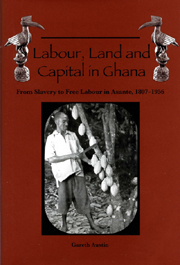Book contents
- Frontmatter
- Contents
- List of Illustrations
- List of Tables
- Preface
- Note on Names
- Maps
- Note on the Maps
- 1 Introduction
- Part I Context and Concepts
- 2 Theories and Debates: Some Tools for Thinking about the History of Property and Markets in Asante and Beyond
- 3 Asante, 1807–1956: The State, Output and Resources
- 4 The Changing Relationship Between Inputs and Output, 1807–1956
- Part II Social Relations of Production and Trade, 1807–1896: Absent and Imperfect Factor Markets
- Part III Slavery as Hobson's Choice: An Analysis of the Interaction of Markets and Coercion in Asante's Era of ‘Legitimate Commerce’, 1807–1896
- Part IV The Decline of Coercion in the Factor Markets of Colonial Asante: Cocoa and the Ending of Slavery, Pawnship and Corvée, 1896–c.1950
- Part V Social Relations of Production and Trade, 1908–1956: Towards Integrated Factor Markets?
- Part VI Freedom and Forest Rent, 1908–1956
- Abbreviations Used in the Notes
- Notes
- List of References
- Index
4 - The Changing Relationship Between Inputs and Output, 1807–1956
from Part I - Context and Concepts
Published online by Cambridge University Press: 12 September 2012
- Frontmatter
- Contents
- List of Illustrations
- List of Tables
- Preface
- Note on Names
- Maps
- Note on the Maps
- 1 Introduction
- Part I Context and Concepts
- 2 Theories and Debates: Some Tools for Thinking about the History of Property and Markets in Asante and Beyond
- 3 Asante, 1807–1956: The State, Output and Resources
- 4 The Changing Relationship Between Inputs and Output, 1807–1956
- Part II Social Relations of Production and Trade, 1807–1896: Absent and Imperfect Factor Markets
- Part III Slavery as Hobson's Choice: An Analysis of the Interaction of Markets and Coercion in Asante's Era of ‘Legitimate Commerce’, 1807–1896
- Part IV The Decline of Coercion in the Factor Markets of Colonial Asante: Cocoa and the Ending of Slavery, Pawnship and Corvée, 1896–c.1950
- Part V Social Relations of Production and Trade, 1908–1956: Towards Integrated Factor Markets?
- Part VI Freedom and Forest Rent, 1908–1956
- Abbreviations Used in the Notes
- Notes
- List of References
- Index
Summary
Having considered the changing stocks of the individual factors we can now examine how they were combined. Let us therefore consider the relationship between output and the inputs of the various kinds of resources: the production function (or rather functions, as they changed over the period). Understanding this is necessary for any analysis of factor markets. The chapter is intended to do much more than summarize existing knowledge. Rather, it puts forward several major propositions about production functions in Asante—ideas which are relevant as hypotheses, arguably, for other settings not only in Ghana but in West, and indeed sub-Saharan Africa more generally.
Section A suggests that is necessary to modify the accepted view in the economic historiography of West Africa that precolonial economies were labour-scarce. Section B observes that the case of Asante cocoa contradicts the vent-for-surplus interpretations of the cash crop revolution in the region. Section C shows that the farmers' characteristic land-extensive methods of growing cocoa made economic sense throughout the colonial period. Section D offers a general statement of the production functions over 1807–1956. In this context it argues that we need to reconsider (and for the colonial period at least, to abandon) the proposition, put forward in notable studies from economists, that in their choice of techniques Asante and other Ghanaian cocoa-farmers essentially substituted labour for capital. Section E considers the evidence about the relationship, if any, between scale of production and efficiency.
- Type
- Chapter
- Information
- Labour, Land and Capital in GhanaFrom Slavery to Free Labour in Asante, 1807–1956, pp. 72 - 96Publisher: Boydell & BrewerPrint publication year: 2005

